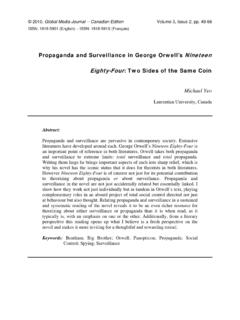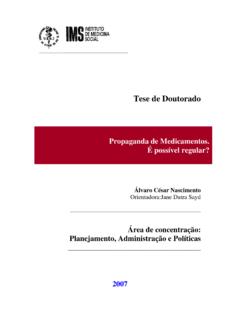Transcription of PMESII and the Non-State Actor: Questioning the Relevance
1 PMESII and the Non-State Actor: Questioning the Relevance A Monograph byMajor Kris A. Arnold United states ArmySchool of Advanced Military Studies United states Army Command and General Staff College Fort Leavenworth, Kansas AY 05-06 Approved for Public Release; Distribution is Unlimited Form Approved REPORT DOCUMENTATION PAGE OMS No. 0704-0188 The public reporting burden for this collection of information is estimated to average 1 hour per response, including the time for reviewing instructions. searching existing data sources, gathering and maintaining the data needed, and completing and reviewing the collection of information.
2 Send comments regarding this burden estimate or any other aspect of this collection of information, including suggestions for reducing the burden, to Department of Defense. Washington Headquarters Services, Directorate for Information Operations and Reports (0704-0188), 1215 Jefferson Davis Highway, Suite 1204, Arlington, VA 22202-4302. Respondents should be aware that not withstanding any other provision of law, no person shall be subject to any penalty for failing to comply with a collection of information if it does not display a currently valid OMB control number.
3 1. REPORT DATE (DD-MM- YYYY) 2. REPORT TYPE 25-05-2006 MONOGRAPH 4. TITLE AND SUBTITLE PMESII and the Non-State Actor: Questioning the Relevance 6. AUTHOR(S) MAJ Kris A. Arnold 7. PERFORMING ORGANIZATION NAME(S) AND ADDRESS(ES) School of Advanced Military Studies 250 Gibbon Ave Ft. Leavenworth, KS 66027 9. SPONSORING/MONITORING AGENCY NAME(S) AND ADDRESS(ES) Command and General Staff College 1 Reynolds Ave Ft. Leavenworth, KS 66027 12. DISTRIBUTION/AVAILABILITY STATEMENT 3. DATES COVERED (From -To) SEPT 2005-MAR 2006 5a. CONTRACT NUMBER 5b. GRANT NUMBER 5c.
4 PROGRAM ELEMENT NUMBER 5d. PROJECT NUMBER 5e. TASK NUMBER 5f. WORK UNIT NUMBER 8. PERFORMING ORGANIZATION REPORT NUMBER 10. SPONSOR/MONITOR'S ACRONYM(S) CGSC, SAMS 11. SPONSOR/MONITOR'S REPORT NUMBER(S) APPROVED FOR PUBLIC RELEASE; DISTRIBUTION IS UNLIMITED 13. SUPPLEMENTARY NOTES 14. ABSTRACT PMESII is an acronym that stands for political, military, economic, social, infrastructure, and information systems. When the adversary is a state all of these systems will be present, and mature, with many of them possessing tangible infrastructure that is easily identified and targeted by surveillance and reconnaissance, and precision weaponry.
5 However, when the adversary is Non-State actor, these same systems will be noticeably missing. Non-State actors are organized fundamentally different than states , and manifest themselves in completely different ways. To apply the systems perspective to Non-State actors , such as Al-Zarqawi, the Al Qaeda leader in Iraq, a different construct is required. The author maintains that identifying the critical requirements of Non-State actors leads to a more relevant construct. Using the Non-State actor Zarqawi, the author identifies four systems that Zarqawi requires to remain viable.
6 These systems are funding, recruitment, information and support, or (FRIS). The FRIS construct provides the same level of utility for the Non-State actor, as PMESII does for states . The author recommends incorporating the FRIS construct as a corollary to the PMESII construct. 15. SUBJECT TERMS PMESII , FRIS, Non-State actors , Zarqawi, Systems Perspective, 16. SECURITY CLASSIFICATION OF: 17 LIMITATION OF 18. NUMBER 19a. NAME OF RESPONSIBLE PERSON ABSTRACT OF PAGES REPORT b. ABSTRACT c. THIS PAGE 19B. TELEPHONE. NUMBER (Include area code) (U) 53 (913) 758-3300 (U) (U) (U) Standard Form 298 (Rev.)
7 8/98) SCHOOL OF ADVANCED MILITARY STUDIES MONOGRAPH APPROVAL Major Kris A. ArnoldTitle of Monograph: PMESII and the Non-State Actor: Questioning the RelevanceApproved by: _____ Monograph Director Alice Butler-Smith, _____ Director, Kevin Benson, COL, AR School of Advanced Military Studies _____ Director, Robert F. Baumann, Graduate Degree Programs iiAbstract PMESII and the Non-State Actor: Questioning the Relevance , by Major Kris A. Arnold, United states Army, 53 pages. A systems perspective is beginning to permeate doctrine.
8 This perspective calls for an analysis of the key systems of an adversary. PMESII is an acronym that stands for political, military, economic, social, infrastructure, and information systems. Analyzing the adversary s PMESII systems can lead to the identification of key nodes, links, and vulnerabilities, which can then be targeted kinetically or non-kinetically to achieve desired effects. The PMESII systems construct applies well when the adversary is a state. All of these systems will be present, and mature, with many of them possessing tangible infrastructure, which can easily be identified byIntelligence, Surveillance, and Reconnaissance, and then targeted with precision weaponry.
9 However, when the adversary is Non-State actor, these same systems will be noticeably missing. Non-State actors are organized fundamentally different than states , and manifest themselves in completely different ways. The utilityof the PMESII construct is significantlydiminished when the adversary is a Non-State actor. To apply the systems perspective to Non-State actors , such as Al-Zarqawi, the Al Qaeda leader in Iraq, a different construct is required. The author maintains that identifying the critical requirements of Non-State actors leads to a more relevant construct.
10 The author, using the Non-State actor Zarqawi, identifies four systems that the typical Non-State actor requires to remain viable. These systems are funding, recruitment, information and support, or (FRIS). The FRIS construct provides the same level of utility for the Non-State actor, as PMESII does for states . The author recommends incorporating the FRIS construct as a corollary to the PMESII construct in the doctrinal manuals and publications that discuss the systems perspective. iiiTABLE OF CONTENTS TABLE OF OF Discuss and the Effects Based of Gravity s link to Parties and and their and : A Vulnerability for : An Enabler for the Non-State s : Oxygen for the Non-State : The Demand for People is : A Key : Required in Many Nature of PMESII and ivTABLE OF FIGURES Figure 1: Identifying Centers of 2: Franks' Slices.











